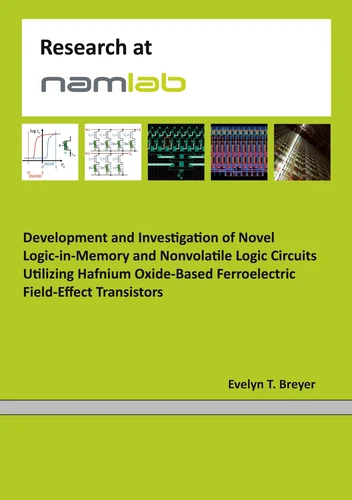Development and Investigation of Novel Logic-in-Memory and Nonvolatile Logic Circuits Utilizing Hafnium Oxide-Based Ferroelectric Field-Effect Transistors
Par :Formats :
Disponible dans votre compte client Decitre ou Furet du Nord dès validation de votre commande. Le format PDF est :
- Compatible avec une lecture sur My Vivlio (smartphone, tablette, ordinateur)
- Compatible avec une lecture sur liseuses Vivlio
- Pour les liseuses autres que Vivlio, vous devez utiliser le logiciel Adobe Digital Edition. Non compatible avec la lecture sur les liseuses Kindle, Remarkable et Sony
 , qui est-ce ?
, qui est-ce ?Notre partenaire de plateforme de lecture numérique où vous retrouverez l'ensemble de vos ebooks gratuitement
Pour en savoir plus sur nos ebooks, consultez notre aide en ligne ici
- Nombre de pages214
- FormatPDF
- ISBN978-3-7557-6897-5
- EAN9783755768975
- Date de parution23/02/2022
- Protection num.Digital Watermarking
- Taille13 Mo
- Infos supplémentairespdf
- ÉditeurA PRECISER
Résumé
Not only conventional computer architectures, such as the von-Neumann architecture with its inevitable von-Neumann bottleneck, but likewise the emerging field of edge computing require to substantially decrease the spatial separation of logic and memory units to overcome power and latency shortages. The integration of logic operations into memory units (Logic-in-Memory), as well as memory elements into logic circuits (Nonvolatile Logic), promises to fulfill this request by combining high-speed with low-power operation.
Ferroelectric field-effect transistors (FeFETs) based on hafnium oxide prove to be auspicious candidates for the memory elements in applications of that kind, as those nonvolatile memory elements are CMOS-compatible and likewise scalable. This work presents implementations that merge logic and memory by exploiting the natural capability of the FeFET to combine logic functionality (transistor) and memory ability (nonvolatility).
Ferroelectric field-effect transistors (FeFETs) based on hafnium oxide prove to be auspicious candidates for the memory elements in applications of that kind, as those nonvolatile memory elements are CMOS-compatible and likewise scalable. This work presents implementations that merge logic and memory by exploiting the natural capability of the FeFET to combine logic functionality (transistor) and memory ability (nonvolatility).
Not only conventional computer architectures, such as the von-Neumann architecture with its inevitable von-Neumann bottleneck, but likewise the emerging field of edge computing require to substantially decrease the spatial separation of logic and memory units to overcome power and latency shortages. The integration of logic operations into memory units (Logic-in-Memory), as well as memory elements into logic circuits (Nonvolatile Logic), promises to fulfill this request by combining high-speed with low-power operation.
Ferroelectric field-effect transistors (FeFETs) based on hafnium oxide prove to be auspicious candidates for the memory elements in applications of that kind, as those nonvolatile memory elements are CMOS-compatible and likewise scalable. This work presents implementations that merge logic and memory by exploiting the natural capability of the FeFET to combine logic functionality (transistor) and memory ability (nonvolatility).
Ferroelectric field-effect transistors (FeFETs) based on hafnium oxide prove to be auspicious candidates for the memory elements in applications of that kind, as those nonvolatile memory elements are CMOS-compatible and likewise scalable. This work presents implementations that merge logic and memory by exploiting the natural capability of the FeFET to combine logic functionality (transistor) and memory ability (nonvolatility).



